Hummingbird Island
Airways
The Rise
and Fall of a Dream
You have not
lived unless you have flown
Seaplanes in the Maldives.

Part One in a Series


![]() A young pilot, David, sent me a long and memorable email. It wasn't just
addressed to me, but to all those he considered e-friends. The idea of the
email was to present a personal questionnaire that everyone was supposed
to fill out and then email to a number of his or her friends. The sharing
or baring of these intimate details of our lives was to bring us all
closer together as friends in that seeing more of each person as an unique
individual would make us more tolerant and understanding.
A young pilot, David, sent me a long and memorable email. It wasn't just
addressed to me, but to all those he considered e-friends. The idea of the
email was to present a personal questionnaire that everyone was supposed
to fill out and then email to a number of his or her friends. The sharing
or baring of these intimate details of our lives was to bring us all
closer together as friends in that seeing more of each person as an unique
individual would make us more tolerant and understanding.
I enjoyed his email and laughed and
was touched by some of his answers, but I did not, regretfully, return the
courtesy. Maybe someday I will, especially now that I can appreciate the
humanism in what he was attempting to accomplish, answer his email
questionnaire and return to sender.
What really touched me, however,
was the answer to one question that related to memorable moments in his
flying travels. I can't remember the question, but the answer was similar
to what I would have written despite our difference of years; him as a
young co-pilot just going Captain, and me after 24 years of flying
experience.
| Standing on the top of the Twin Otter watching the whales surfacing. Flying over the mountains newly covered in snow. Listening to the sounds of the evening prayer call as you prepare to leave the Maldives, possibly for the last time. |
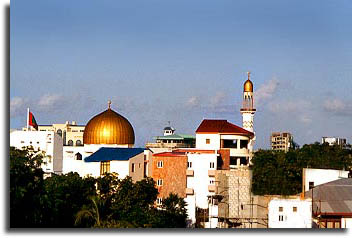 That
is not how he phrased his answers, but that is how I remember the common
ground. We had shared experiences as bush pilots and as such had found a
bond, especially so after having both flown in the Maldives. David flew
for the floatplane operator Maldivian Air Taxi, and I flew for the upstart
Hummingbird Island Airways. It did not matter who we flew for the
experiences were the same and we both remember our time in the Maldives
with special heart felt warmth.
That
is not how he phrased his answers, but that is how I remember the common
ground. We had shared experiences as bush pilots and as such had found a
bond, especially so after having both flown in the Maldives. David flew
for the floatplane operator Maldivian Air Taxi, and I flew for the upstart
Hummingbird Island Airways. It did not matter who we flew for the
experiences were the same and we both remember our time in the Maldives
with special heart felt warmth.
Kit Chambers would not have described
the air service he started as an upstart company, but when he first turned
a blade it was a rotor blade and the idea of flying floatplanes had not
yet been introduced. Kit Chambers started a helicopter transfer service to
a few select islands within the tourist-designated areas that were
considered too far or uncomfortable for regular sea-going boat transfer.
 In
fact, Chambers was the first pilot to start island transfers in the
Maldives. His innovative idea, that came to fruit, was to move incoming
tourists from the International Airport to the resort islands by
helicopter. Thus Hummingbird Helicopters was born. As with any good idea
they had imitators and had to battle an idea stealing Seagull Helicopters.
Eventually Hummingbird won, but at a financial drain to the company.
In
fact, Chambers was the first pilot to start island transfers in the
Maldives. His innovative idea, that came to fruit, was to move incoming
tourists from the International Airport to the resort islands by
helicopter. Thus Hummingbird Helicopters was born. As with any good idea
they had imitators and had to battle an idea stealing Seagull Helicopters.
Eventually Hummingbird won, but at a financial drain to the company.
The next company battle Hummingbird
Helicopters fought and eventually lost was with Maldivian Air Taxi. MAT,
as they are known locally, had the idea of bringing floatplanes or
seaplanes into the Maldives. The helicopters offered the hub and spoke
concept of transfers where they brought the tourists to the nearest
licenced helipad and the resorts would send out their dhonis, local wooden
boats, to pick up the passengers. MAT bettered that by offering "door
to door" service where they could land the floatplanes right into the
individual lagoons of each resort, thus eliminating the often long and
trying boat rides from the helipads.
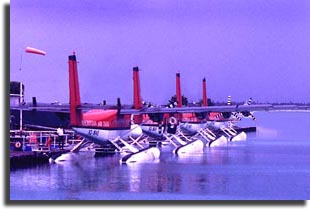 It wasn't long before MAT started
taking the majority of the air transfer business in the Maldives and
Hummingbird Helicopters was again being taxed financially. The reason I
called Hummingbird the upstart airline earlier was because at this point,
in order to survive, Hummingbird had to reinvent itself as a seaplane
operation and phase out the expensive daytime helicopter transfers.
It wasn't long before MAT started
taking the majority of the air transfer business in the Maldives and
Hummingbird Helicopters was again being taxed financially. The reason I
called Hummingbird the upstart airline earlier was because at this point,
in order to survive, Hummingbird had to reinvent itself as a seaplane
operation and phase out the expensive daytime helicopter transfers.
That is where I came in. Hummingbird
was going to make a new start with two amphibious Caravans and two float
Twin Otters, as well as keeping the Bulgarian run contact for the three
Mil-8 helicopters and crew. I had been offered the position of Chief Pilot
Fixed Wing for Hummingbird, but by the time I made up my mind the position
was taken. I settled for Training Captain on the Caravans and was actually
relieved because secretly I was longing to live the simple life in the
tropical Maldives.
My wife and I had looked up the
images on the internet, and the blue waters, green palm trees, and soft
white sand beaches reminded us of our days in Fiji. That was the idyllic
life we were longing for and wished to go back to. As Training Captain my
life would be simple and uncomplicated leaving me time for my family. Or
that is what we thought.
In the middle of the cold Canadian
winter, when the snow was drifting over the driveway, my wife, my
nine-year-old son, and myself made it over to the Winnipeg airport to
board Air Canada enroute to Male the capital of the Republic of Maldives.
Our connection was through Los Angeles and then on to Kuala Lumpur with
Malaysian Airlines.
The rest-break in Malaysia was planned
to relieve the jet lag as we were circumnavigating the long way round. The
Maldives was over halfway around the globe from Winnipeg, and precisely
halfway from Vancouver, including 12 hours time difference on the clock.
When we travelled home we went through Europe and could truthfully say,
“We had been around the world.”
We thoroughly enjoyed our stopover in
the Southeast Asian city, and did all the touristy things that tourists
do. We were not made to feel like foreigners at all. Our gentle
introduction to Asia did not, however, prepare us for the Maldivian way of
doing things.
We arrived in Male late in the
evening and the confusion started. First of all, the immigration ignored
my attempt to explain that I have come in to work for a local company.
They stamped me as a tourist with only a 30-day stay. Customs then
insisted on x-raying our entire luggage of which we had lots having come
to live there. The customs asked why, if we were tourist, did we have so
much luggage? I explained that I have come to work, but immigration wouldn’t
listen to me. Customs then led me back to immigration where we finally
straightened out my passport when the officer realized that he had a
prearranged visa waiting for me from Hummingbird Island Airways.
That settled, the customs officials
then x-rayed our luggage and the real Maldivian character emerged. The
Maldives Republic is Muslim and in order to protect their peoples they
search all suspect imports for booze, pornography, and pork products. It
was obvious to everyone there, except to myself, my wife, and my young
son, that we were likely suspects for being smugglers. They tore apart
every one of our nine suitcases and of course could not find anything. In
their zealousness they eventually confiscated my son’s 20 plus videos
tapes. These tapes were my son’s personal collection from his life in
theater-less Nigeria, and included classics such as "Winnie the
Pooh", "Aladdin", and "Honey I Shrunk the Kids."
Neither my son nor my wife had ever
been subjected to this kind of single-minded censorship that led them to
declare my son’s Disney videos as possible pornography. As they filed
away my son’s videos one by one my son went from friendly persuasion to
logical arguments to frustrated crying, but to no avail. They ignored him
and my wife and set the tone of our next two years in the Maldives. Quiet
dogmatic bureaucracy prevailed. They never argued, they never angered;
they just followed the rules. That dogma permeated throughout the society
and coloured everything we did in introducing floatplanes to Hummingbird
Island Airways.
The next morning the sun was shining
and the sky was blue, and the enormous Flame trees were heavy with bright
red flowers. We were in the obviously tropical Maldives and the previous
night’s theft of our possessions was not going to damper our spirits.
The Chief Pilot, Jimbo, came to show us around. The yellow warm morning
light filtered in through the heavy green leaves of the mango trees, and
streamed in around the tightly packed buildings crowded along the narrow
interlocking brick streets. White taxis and skinny men on bicycles hurried
along as the city came alive.
 Jimbo, with an disarming smile and a
friendly demeanor, led myself and my family through the crowded dusty
streets to visit the tailor for my uniforms, the photographer for my
pictures, and the hospital for my immigration required work medical in
order to get the entire procedure under way toward getting me licenced and
flying. The GM who hired me had initially promised me two weeks off when I
arrived in order to get oriented and get my family settled, but things had
changed between the time we left home until the time we arrived. Even when
the promise was made, my wife rolled her eyes and laughed, saying “yeah,
right.” We had been in the business too long to think that promise would
ever be kept. We both just shrugged our collective shoulders when Jimbo
announced that I was needed online as soon as bureaucratically possible.
Jimbo, with an disarming smile and a
friendly demeanor, led myself and my family through the crowded dusty
streets to visit the tailor for my uniforms, the photographer for my
pictures, and the hospital for my immigration required work medical in
order to get the entire procedure under way toward getting me licenced and
flying. The GM who hired me had initially promised me two weeks off when I
arrived in order to get oriented and get my family settled, but things had
changed between the time we left home until the time we arrived. Even when
the promise was made, my wife rolled her eyes and laughed, saying “yeah,
right.” We had been in the business too long to think that promise would
ever be kept. We both just shrugged our collective shoulders when Jimbo
announced that I was needed online as soon as bureaucratically possible.
As I had worked overseas for many
years, I had a good handle on what was expected of me for the licencing.
Although the Maldivian department of the DCA, or Director of Civil
Aviation, had a very complicated licencing procedure, I managed to have
the right documents at the right time to speed up the process. First of
all, they had already, long before my arrival, gotten a photocopy of my
Canadian ATPL so that they could physically contact Transport Canada and
verify the validity of my licence. Transport Canada had faxed back to them
that yes indeed my licence was valid and they had no violations or
suspensions on record. In essence they verified my ATPL was real.
Thus, with a valid verified ATPL, a
valid medical within 6 months, a C208 type rating on my Cdn licence, a 6
month current PPC ride on my ICAO Nigerian licence, and two stamp size
photographs, I was ready to fly only 2 days after my arrival in the
Maldives. The department of the Director of Civil Aviation issued me what
they call an Authorization permit. That means I can fly legally within the
Maldives based on my Cdn licence that has been so authorized. That would
give me 90 days in which to obtain my DCA medical and write the Air Laws
after which they would issue me a real Maldivian Pilot Licence. Next,
however, would come the familiarization flights.
Jimbo, being the Chief Pilot had the
duty of bringing me to the airport and introduced me to the pilots who had
preceded me into the floatplane operation. Jimbo himself was ex-Ken Borek
and was one of the most experienced and qualified Twin Otter pilots in the
business. Jimbo was a wealth of Twin Otter tales of woe that he was happy
to regale you with especially over the business of a beer. He introduced
me to the two new-to-the-Caravan pilots who were to become the backbone of
the single engine operation.
Rod and Ian were both Aussies
from widely diverse backgrounds and experience, but both were excellent
floatplane pilots in their own right. The third pilot, George, who was
away at the moment, was ex-Maldivian Air Taxi, and was only here with
Hummingbird for the short introductory period. He had been in the Maldives
before and had only agreed to come over from the U.S. to help start the
Caravan operation. He would soon be leaving now that I had finally
arrived.
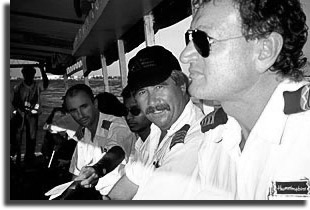 Rod was a veteran of PNG and anyone
who knows anything about the conditions of flying in the mountain regions
of Papua New Guinea would know that Rod had to be a better than average
aviator. He was definitely a survivor and knew how to calculate the
inherent risks in any new venture. He was both cautious and deliberate and
his decision making process was hard to fault.
Rod was a veteran of PNG and anyone
who knows anything about the conditions of flying in the mountain regions
of Papua New Guinea would know that Rod had to be a better than average
aviator. He was definitely a survivor and knew how to calculate the
inherent risks in any new venture. He was both cautious and deliberate and
his decision making process was hard to fault.
Unfortunately, within his first two
weeks of flying the Caravan he had been the one to leave the water rudders
down for take-off and discover that can’t be done on the Wipaire floats.
Like he pointed out, it says right in the Wipaire manual that for
crosswind take-offs it is advisable to leave the rudders down for better
control. What it doesn’t say is that the water rudders are one of the
weak links in the otherwise excellent amphib floats. You only cautiously
leave the water rudders down for the initial part of the take-off run, and
you never leave them down for landings or during backing up, but it was a
common mistake for floatplane pilots transitioning from Beavers.
Any one of these operations can rip
the rudder assembly right off the heel of the aircraft leaving a hole
large enough to sink the aircraft - given time. Because the control wires
run internally, if the back float compartment gets holed, the water will
eventually force itself through the access holes in the bulkheads and,
like the Titanic, fill each compartment along the way. Although I don't
believe it has ever happened, it is possible and a few pilots have come
very close to sinking their Caravans. As the Edo’s don’t have the same
such problems, the worst that will usually happen to Beaver pilots is that
they will have to buy the boys a case of beer if caught with their water
rudders down.
 Ian, on the other hand, was relatively
inexperienced although he had accumulated over 5000 hours on floats. Most
of his time was on the Beaver flying the Australian East Coast, and on the
C185 up the rivers of Tasmania. With the glorious sunshine and clear skies
in the Land of Oz, Ian confessed that he had never flown IMC. He had
basically never flown through a rainstorm or gone zero/zero in cloud or
fog. That did not detract from his floatplane skills that were superb. In
Fiji, 15 years before, I had checked out several Aussie pilots on floats
and, at the time, they were somewhat awkward in technique. Ian wasn’t
and could finesse his way in and out of some frightfully restricted coral
reef channels or awfully large and tumultuous seas.
Ian, on the other hand, was relatively
inexperienced although he had accumulated over 5000 hours on floats. Most
of his time was on the Beaver flying the Australian East Coast, and on the
C185 up the rivers of Tasmania. With the glorious sunshine and clear skies
in the Land of Oz, Ian confessed that he had never flown IMC. He had
basically never flown through a rainstorm or gone zero/zero in cloud or
fog. That did not detract from his floatplane skills that were superb. In
Fiji, 15 years before, I had checked out several Aussie pilots on floats
and, at the time, they were somewhat awkward in technique. Ian wasn’t
and could finesse his way in and out of some frightfully restricted coral
reef channels or awfully large and tumultuous seas.
As Jimbo wasn’t checked out on the
Caravan, he delegated my area check out to Rod and Ian. Ian had been in
country for some time and had been originally checked out on the Caravan 6
weeks before by George. Rod had come later and had only started on the
Caravan less than two weeks ago.
As it turned out the small world
syndrome was in play here as George had flown the original MAT straight
float Caravan that had sunk in the Maldives, been salvaged and rebuilt by
Ken Borek, painted orange, and sold to Slate Falls Airways. That was the
aircraft that I had flown several years before when I checked out the
Slate Falls pilots on their newly acquired Caravan.
I never did get the story straight
however on how the Caravan sunk in the first place. Most accounts have it
sinking at the dock because someone left the fuel selectors on and the
fuel all flowed to one wing causing the wing to catch the water and turn
turtle. The other version is that the floats were so badly beat up from
the rough water and the aircraft was so neglected as the orphan of the
fleet that the floats filled up with water over night at the dock and the
aircraft sunk. Dave, the diver who salvaged the plane, says it was the
former I believed him. One Hummingbird pilot left his fuel selectors on
during a 30-minute shutdown and had a 300 lb imbalance. When I witnessed
him taxing out, luckily empty, he was very near to disaster. I can see if
the plane were left overnight with the selectors on the imbalance
difference would be too much for the floats to handle.
As for the other Hummingbird Caravan,
someone made the wing ropes too long and consequently one caught in the
tracks during flap retraction. The out of place rope had severely bent the
tracks and cracked the flap hangers. Making the wing ropes too long was
another common mistake Beaver pilots make when converting onto the
Caravans. Thus, both Hummingbird Caravans were effectively grounded when I
arrived in country on Feb 01st.
The solution to get one airborne was
to take parts off one and make whole the other Caravan, and that is what
Ken, the Canadian Chief Engineer, did. He had taken the rudder assembly
off the new Caravan, 8Q-HIC, and placed it on the other Caravan, 8Q-HID,
to make one aircraft out of two. This necessity to resort to
cannibalization so early in the airlines’ operational life was
disconcerting to me. The MD and GM had at least 6 months to prepare for
the arrival of the aircraft and yet there was not a spare part in country.
That was a sign of times to come, but right now I put those thoughts aside
as I climbed aboard for my first flight in the Maldives.
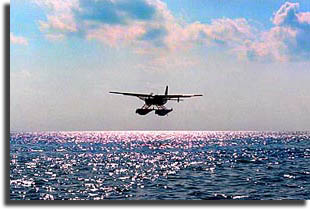 February 03rd, 1997,
Rod lifted 8Q-HID smoothly off the runway of the Male International
Airport northwest bound for Kudafolhudhoo Island, or Nika Resort, which is
a tiny coral island on the north tip of South Ari Atoll. Hummingbird at
that time had no floatplane contracts, but they still had the 3 Mil-8’s
and the helicopter transfer contracts. Although not always strictly
contract legal, whenever the dispatchers could, in an attempt to start
introducing the floatplanes to the operation and to lower the cost of
passenger transfer, they would send the smaller loads on either the Twin
Otters or the Caravans.
February 03rd, 1997,
Rod lifted 8Q-HID smoothly off the runway of the Male International
Airport northwest bound for Kudafolhudhoo Island, or Nika Resort, which is
a tiny coral island on the north tip of South Ari Atoll. Hummingbird at
that time had no floatplane contracts, but they still had the 3 Mil-8’s
and the helicopter transfer contracts. Although not always strictly
contract legal, whenever the dispatchers could, in an attempt to start
introducing the floatplanes to the operation and to lower the cost of
passenger transfer, they would send the smaller loads on either the Twin
Otters or the Caravans.
Nika Resort had agreed to utilize the
floatplanes, however, as the helipad was a short distance away on another
island. With the floatplanes we could land and tie up right on their
island jetty making passenger transfer a simple business. Nika had almost
given up their business to MAT, but agreed to stay with Hummingbird when
they said they were switching to floatplanes. On this trip to Nika we were
only to drop off two and pick up five. That load was definitely a money
loser for the 22 passenger Mil-8 helicopter and anything else, except the
Caravan.
Rod climbed to 2000 feet enroute to
the South Ari Atoll. As he leveled off I got to see the Indian Ocean in
all its glory. The day was slightly hazy, but the landscape or should I
say seascape was indistinguishably Maldivian. I was not expecting a “Fiji”,
but certainly the Maldives is of another world. A thousand low lying
islands in a picture perfect setting of about 8 double strings of pearls
on a velvet azure backdrop, strung out for a thousand miles north to
south, is the best way to visualize the island country.
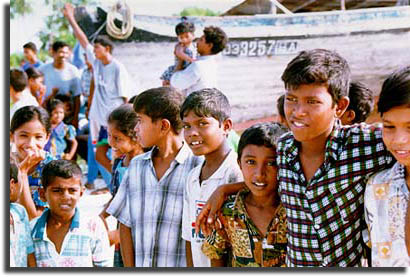 In fact, it is really hard to
understand the Maldives as a country unless you think of it as a Republic
of Island Peoples. The people are most likely a collection of Indian, Sri-Lankan,
and Arabic descent, who mixed to become distinctively Maldivian. Despite
their similarities, the northern islanders distinguished themselves from
the southerners. The indigenous inhabitants of Male, for example, claim
that it is the southern islanders who are the go-getters of their society
and who have taken over the northern capital with their industry and
commerce.
In fact, it is really hard to
understand the Maldives as a country unless you think of it as a Republic
of Island Peoples. The people are most likely a collection of Indian, Sri-Lankan,
and Arabic descent, who mixed to become distinctively Maldivian. Despite
their similarities, the northern islanders distinguished themselves from
the southerners. The indigenous inhabitants of Male, for example, claim
that it is the southern islanders who are the go-getters of their society
and who have taken over the northern capital with their industry and
commerce.
The lands they inhabit are coral
islands formed around ancient volcanoes that sunk into the ocean millions
of years ago. At one time there must have been a pair of volcanic hot
spots that would push up one molten island after another as the Sub-
Continental Indian plate plowed northward. It was as if a fixed position
sewing machine was poking holes in the plate from below as the fabric of
plate material swept along. From each hole bled the molten lava making
mountains and islands that for many millenniums must have resembled the
Hawaiian Islands. Coral grew around the base of the islands, and when the
heavy islands sunk they left the living coral reefs behind, in somewhat
irregular circles, to continue struggling to find a balance between
staying near the sunlit surface and yet staying submerged enough to
sustain oceanic life.
The elongated geological shape of the
main coral reef atolls that remain are positioned north to south according
to the movement of the tectonic geological plates. But, the smaller and
newer coral lagoons and cays are elongated according to the prevailing
winds of the strongest monsoon, the northwest monsoon that blows from
about mid-April to November. That does not mean, however, that the lagoons
are elongated SE to NW. The strongest winds of the northwest monsoon
actually occur when the winds swing around to the west and northwest.
Believe me, learning the seasonal winds were very difficult.
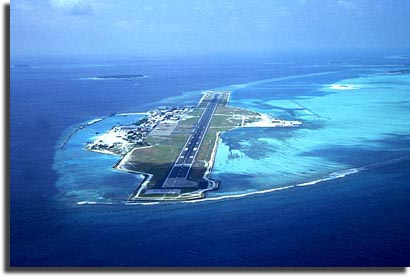 The
worst part of the phenomena is that the international airport’s only
runway is situated north to south to follow the lie of the Huhule Island
it is built on. That means that when the winds are light and variable they
are right down the runway. As the winds increase, during the northwest
monsoon, they will swing westerly and consequently dead across the runway.
When the winds reach their peak at 35 – 45 knots they are 270 degrees
and a perfect 90-degree crosswind.
The
worst part of the phenomena is that the international airport’s only
runway is situated north to south to follow the lie of the Huhule Island
it is built on. That means that when the winds are light and variable they
are right down the runway. As the winds increase, during the northwest
monsoon, they will swing westerly and consequently dead across the runway.
When the winds reach their peak at 35 – 45 knots they are 270 degrees
and a perfect 90-degree crosswind.
One of the Aussies pilots who came
later, Robbie, who is without doubt one of the best natural born pilot I
have ever met, showed me, (as I was checking him out!) how to land the
Caravan amphib in a 30 knot 90 degree crosswind. I had seen enough of his
flying to know he could do it, but to sit in the front right seat and
watch him do it took a lot of control on my part not to wave him off for a
go around. It was like watching a bald eagle hovering over a naked branch
in a ferocious wind. He worked the controls like muscles working feathers
and wings, and perched her down, always on the edge, but perfectly in
control.
We had an easier time with the Twin
Otters, based out of the eastern floatplane base, when the winds came up,
simply because we could land them into the west wind. The east west water
landing area was awfully short, but of course the stronger the wind the
less room we needed.
December to mid-April are considered
the tourist months as they coincide with the gentler winds and lesser
rains of the south-easterly monsoon,. The amazing part about the Maldives
is that there is no real absolute dry season and that fact is reflected in
the palm trees and bushes staying green all year round. The islands stay
lush, tropical, and inviting throughout the seasons.
Article and Images by John S Goulet
Continue with Part Two
![]()
Note from the Editor. Hummingbird Helicopters became Hummingbird Island Airways, and Hummingbird Island Airways no longer exists. It has been sold out, and reincarnated as Trans Maldivian Airways. This story is about the two years it was HIA.
![]()
Use the attitude indicator as your guide back to Knowledge Based
Stories.
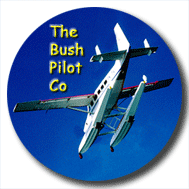 Top of this
page.
Top of this
page.
Last modified on
March 05, 2006 .
© Virtual Horizons, 1996.
